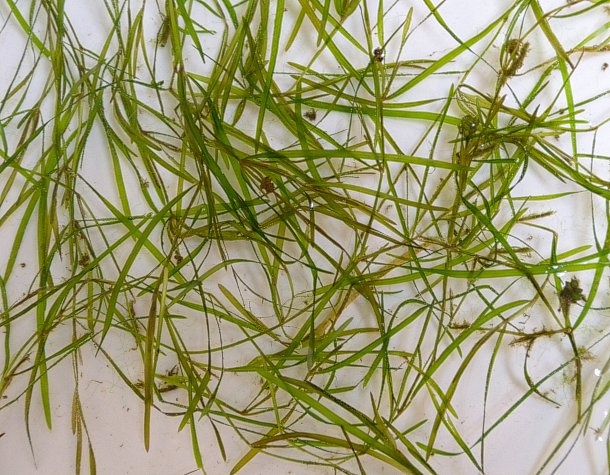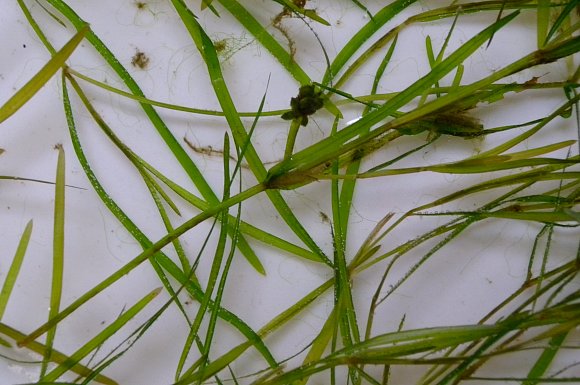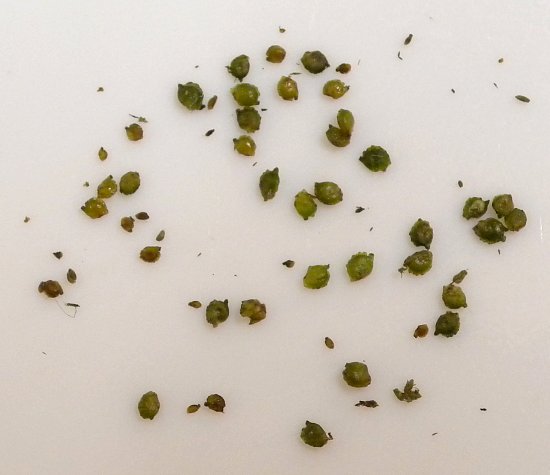
The blooming period occurs during mid- to late summer, lasting about 3 weeks for a colony of plants. The flowers are cross-pollinated by water currents. Afterwards, fertile flowers are replaced by achenes (up to 4 achenes per flower). These achenes are 1.25-2.25 mm. long and 1.00-1.75 mm. across; they are green to brownish green, ovoid-globoid in shape, somewhat flattened, smooth-sided, short-beaked, and keeled. The sharp keels of these achenes are winged and crested (appearing toothed). The bases of some achenes may have a minute tooth-like projection. This aquatic plant also produces narrow turions (winter buds) that are up to 1 cm. long and 2 mm. across. The root system is fibrous. Sometimes fibrous roots develop from the lower nodes of stems that are decumbent on bottom sediment. This aquatic plant can spread vegetatively from the breakage of leafy stems that drift in water to new areas.
Cultivation: The preference is full sun, shallow clear water that is stagnant or slow-moving, and bottom sediment containing silt, mud, and/or organic matter. Desirable water pH can be mildly acidic to alkaline. Leafy Pondweed (Potamogeton foliosus) can spread aggressively in some wetlands. However, this pondweed will decline in abundance when it occurs in water that is too muddy from suspended sediments, or that contains too much fertilizer (e.g., nitrogen and phosphorus) from agricultural or suburban run-off. The latter problem can cause excessive competition from filamentous algae.

Range & Habitat: Leafy Pondweed (Potamogeton foliosus) is common in most areas of Illinois (see Distribution Map), where it is native. This pondweed is widely distributed in North America. Habitats consist of spring-fed streams, slow-moving creeks, ponds, sheltered areas of lakes, drainage canals, and ditches that contain water during most of the year. This pondweed adapts to shallow water better than most pondweed species (Potamogeton spp.) and it is often common in disturbed wetland habitats, particularly when there is protection from waterfowl or fish.
Faunal Associations: The larvae of some shore flies (Ephydridae), including Hydrellia ascita and Hydrellia cruralis, feed on the submerged leaves of this pondweed, as do the larvae of Parapoynx allionealis (Watermilfoil Leafcutter Moth). Larvae of the aquatic beetles Neohaemonia flagellata, Neohaemonia melsheimeri, and Neohaemonia nigricornis feed on the submerged stems and roots of various pondweeds (Potamogeton spp.). For a more complete list of insect feeders for pondweeds, see the Insect Table. Because of its soft fine foliage and relative abundance, Leafy Pondweed is one of the more important sources of food for vertebrate animals among the various pondweeds. Both the seeds and foliage are eaten by many ducks, geese, swans, and other birds (see Bird Table). Submerged pondweeds are also eaten by carp and other kinds of fish (see Forbes, 1888), and they are eaten by such turtles as Chelydra serpentina (Snapping Turtle), Chrysemys picta (Painted Turtle), Emydoidea blandingii (Blanding's Turtle), Graptemys ouachitensis (Ouachita Map Turtle), Graptemys pseudogeographica (False Map Turtle), Sternotherus odoratus (Musk Turtle), and Trachemys scripta (Slider); see Lagler (1943) and Ernest et al. (1994). Muskrats also feed on these plants (Hamerstrom & Blake, 1939; Martin et al., 1951/1961). Because Leafy Pondweed often forms dense mats of leafy stems, it provides good cover for minnows, aquatic insects, and other aquatic organisms.

Photographic Location: Photographed plants were collected from a ditch in Savoy, Illinois.
Comments: This common pondweed has a rather grassy appearance. It can be difficult to distinguish Leafy Pondweed (Potamogeton foliosus) from other submerged pondweeds (Potamogeton spp.) with linear leaves unless the floral spikes are present. Compared to these species, the floral spikes of Leafy Pondweed are very short and densely flowered, and they have shorter peduncles (3-12 mm.). In addition, the leaves of Leafy Pondweed usually lack visible glands and its stems are flattened, rather than terete. The achenes of this pondweed are also distinctive because of their winged crested keels, which are visible to the naked eye. Different varieties of Leafy Pondweed have been described across its geographic range, although they tend to intergrade. In Illinois, it is the typical variety (Potamogeton foliosus foliosus) that is commonly encountered.